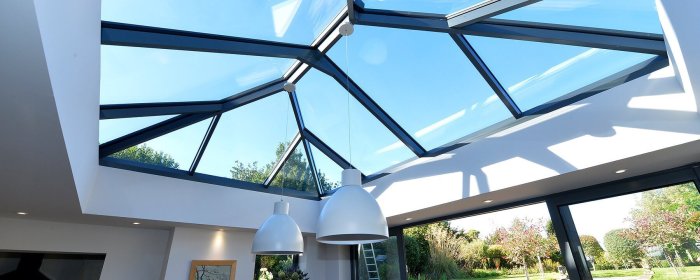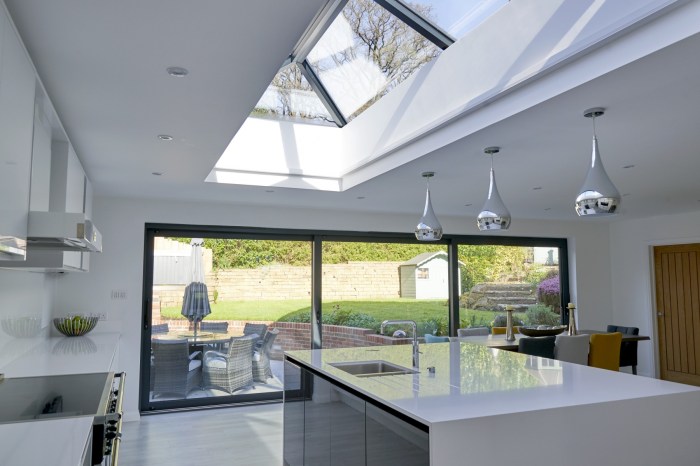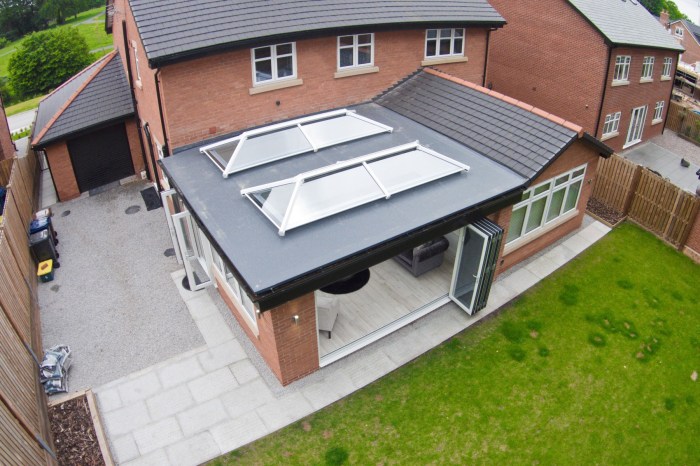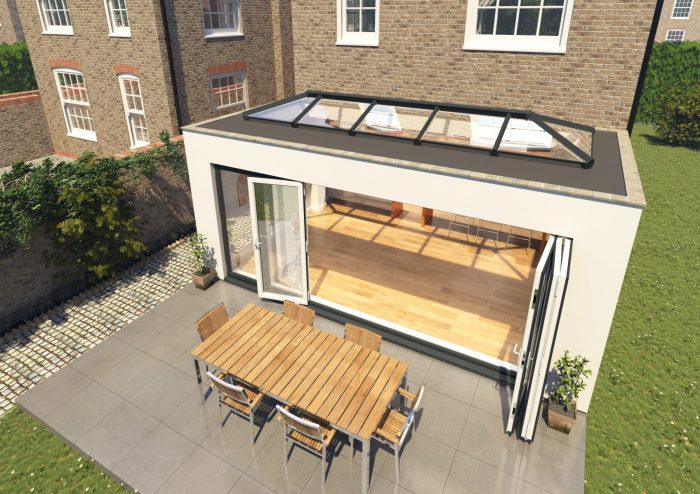Embark on a journey of architectural artistry with lantern roof extension ideas, where natural light becomes your muse and extended living spaces inspire endless possibilities. From innovative design concepts to functional benefits, this guide unveils the transformative power of lantern roof extensions, empowering you to create a home that is both visually stunning and exceptionally livable.
Immerse yourself in a world of design possibilities, explore the latest trends, and discover how lantern roof extensions can seamlessly complement your home’s architectural style. Dive into the practical aspects, including material options, installation processes, and maintenance tips, to ensure your lantern roof extension is a long-lasting investment in beauty and comfort.
Design Ideas

Lantern roof extensions are a popular way to add extra light and space to your home. They can be designed in a variety of styles to suit any taste, from traditional to contemporary.
When designing a lantern roof extension, it is important to consider the following factors:
- The size and shape of the extension
- The materials used
- The style of the extension
- The amount of natural light you want to let in
There are many different design concepts for lantern roof extensions. Some popular options include:
- Gable-end lantern roofs:These roofs have a pitched roof with a lantern at the top. They are a traditional design that is often used on period properties.
- Hipped-end lantern roofs:These roofs have a hipped roof with a lantern at the top. They are a more modern design that is often used on contemporary properties.
- Flat-roof lantern roofs:These roofs have a flat roof with a lantern at the top. They are a simple and modern design that is often used on extensions to contemporary properties.
The materials used for lantern roof extensions can also vary. Some popular options include:
- Timber:Timber is a traditional material that is often used for lantern roof extensions. It is a strong and durable material that can be stained or painted to match the existing property.
- Aluminium:Aluminium is a modern material that is often used for lantern roof extensions. It is a lightweight and durable material that is available in a variety of colours.
- UPVC:UPVC is a plastic material that is often used for lantern roof extensions. It is a low-maintenance material that is available in a variety of colours.
The style of the lantern roof extension should be chosen to match the existing property. For example, a traditional property would be best suited to a gable-end lantern roof, while a contemporary property would be best suited to a flat-roof lantern roof.
The amount of natural light you want to let in will also affect the design of the lantern roof extension. If you want to let in a lot of natural light, you will need to choose a lantern roof extension with a large glazed area.
Material Options

Choosing the right material for your lantern roof extension is crucial. Each material offers unique advantages and drawbacks in terms of durability, cost, and maintenance.
Glass
Pros
Natural light
Glass allows ample natural light to flood your home, creating a bright and airy space.
Durability
Glass is a durable material that can withstand extreme weather conditions.
Aesthetics
Glass provides a sleek and modern look to your home.
Cons
Cost
Glass is a more expensive material compared to polycarbonate or aluminum.
Weight
Glass is heavy, requiring a robust support structure.
Maintenance
Glass requires regular cleaning to maintain its transparency.
Polycarbonate
Pros
Cost-effective
Polycarbonate is a more affordable option than glass.
Lightweight
Polycarbonate is lightweight, making it easier to install.
Impact-resistant
Polycarbonate is highly resistant to impact, making it suitable for areas prone to hail or debris.
Cons
Yellowing
Polycarbonate can yellow over time, especially when exposed to UV rays.
Scratches
Polycarbonate is more prone to scratches than glass.
Insulation
Polycarbonate provides less insulation than glass.
Aluminum
Pros
Durability
Aluminum is a strong and durable material that can withstand harsh weather conditions.
Low maintenance
Aluminum requires minimal maintenance and is resistant to corrosion.
Cost-effective
Aluminum is a relatively cost-effective option compared to glass.
Cons
Heat retention
Aluminum can retain heat, making it less suitable for warmer climates.
Aesthetics
Aluminum may not offer the same aesthetic appeal as glass.
Condensation
Aluminum can be prone to condensation, especially in humid environments.
Functional Benefits
Lantern roof extensions offer a myriad of functional benefits that can transform a home’s comfort, livability, and overall aesthetic appeal.
One of the most significant advantages is the increased natural light they provide. The expansive glass panels allow ample sunlight to flood into the living space, creating a brighter and more inviting atmosphere. This natural illumination not only enhances the overall ambiance but also reduces the reliance on artificial lighting, leading to energy savings.
Improved Ventilation, Lantern roof extension ideas
Lantern roof extensions play a crucial role in improving ventilation within a home. The adjustable roof panels can be opened to allow fresh air to circulate, reducing moisture buildup and creating a healthier indoor environment. This feature is particularly beneficial in areas with limited cross-ventilation or during the warmer months when natural ventilation is essential for maintaining a comfortable indoor temperature.
Added Space
Lantern roof extensions can significantly expand the living space of a home. The additional headroom and floor area created by the extension provide ample room for various activities and can accommodate larger furniture pieces. This extra space can be utilized for a variety of purposes, such as creating a cozy seating area, a home office, or even a small guest room.
Architectural Styles

Lantern roof extensions are versatile additions that can seamlessly blend with various architectural styles. They offer a harmonious balance between traditional and contemporary aesthetics, complementing the existing architectural features while introducing a touch of modern elegance.
The adaptability of lantern roof extensions lies in their ability to enhance the natural light and spatial volume of a space. By incorporating large glazed panels, they create a sense of openness and airiness, transforming even the most compact rooms into light-filled havens.
Compatibility with Different Styles
- Traditional Styles:Lantern roof extensions can effortlessly complement traditional architectural styles such as Victorian, Edwardian, and Georgian homes. The intricate detailing and decorative elements of these styles are beautifully accentuated by the addition of a lantern roof, which adds a touch of contemporary flair without compromising the historical charm.
- Contemporary Styles:Modern and contemporary architectural styles embrace clean lines, geometric shapes, and open-plan living. Lantern roof extensions are a perfect match for these styles, as they provide ample natural light and create a spacious and airy feel. The minimalist design of lantern roofs allows them to seamlessly integrate with the sleek and sophisticated aesthetics of contemporary homes.
- Transitional Styles:Transitional architectural styles blend elements of both traditional and contemporary design. Lantern roof extensions can serve as a bridge between these two worlds, offering a harmonious combination of classic and modern features. They can enhance the traditional elements of a transitional home while introducing a touch of contemporary elegance.
Planning Considerations
When planning a lantern roof extension, several key considerations must be addressed to ensure a successful project. These include adhering to building codes, meeting structural requirements, and optimizing site orientation.
To obtain necessary permits and approvals, it’s essential to submit detailed plans and specifications to the local building authority. A thorough review process will ensure compliance with building regulations and safety standards.
Tips for a Successful Planning Process
- Engage with a qualified architect or designer to create comprehensive plans.
- Research local building codes and zoning restrictions to avoid potential delays.
- Consult with structural engineers to assess the feasibility of the design and ensure its stability.
- Consider the orientation of the site to maximize natural light and minimize energy consumption.
- Communicate regularly with the building authority to address any queries or concerns.
Installation Process
Installing a lantern roof extension involves meticulous planning and careful execution. The general process comprises several key stages, each requiring specialized techniques and equipment.
The initial step entails preparing the existing roof by removing any existing tiles or slates. Next, the supporting structure for the lantern is constructed, typically using timber or steel beams. The lantern’s frame is then assembled and lifted into place, ensuring precise alignment and stability.
Securing the Lantern
Once the frame is in position, it is securely fixed to the supporting structure using specialized brackets and bolts. This ensures the lantern’s structural integrity and resistance to external forces.
Roofing and Glazing
The next stage involves installing the roofing material, such as tiles or slates, onto the lantern’s framework. This provides weatherproofing and a seamless transition between the lantern and the existing roof.
Finally, the lantern’s glazing is installed, utilizing high-quality glass panels that provide ample natural light and enhance the overall aesthetic appeal.
Tips for a Smooth Installation
- Hire experienced contractors who specialize in lantern roof installations.
- Obtain necessary building permits and adhere to local building codes.
- Use high-quality materials and components to ensure durability and longevity.
- Inspect the installation regularly to identify any potential issues and address them promptly.
li>Plan the installation carefully, considering factors such as weather conditions and access to the roof.
Maintenance and Upkeep
Lantern roof extensions require regular maintenance to ensure their longevity and functionality. Proper care involves cleaning, inspections, and addressing potential issues promptly.
Cleaning and Maintenance
Regular cleaning helps prevent dirt and debris accumulation, which can affect the extension’s appearance and performance. Use a mild detergent and a soft cloth to clean the exterior surfaces. Avoid harsh chemicals or abrasive materials that may damage the finish.
For interior surfaces, dust and vacuum regularly to remove dust and cobwebs.
Cost Considerations

The cost of lantern roof extensions varies depending on several factors, including the size, materials used, and complexity of installation. Generally, larger extensions with more elaborate designs and premium materials will cost more than smaller, simpler extensions with standard materials.
Factors Affecting Cost
-
-*Size
The larger the extension, the more materials and labor will be required, increasing the overall cost.
-*Materials
The choice of materials for the frame, glazing, and roofing can significantly impact the cost. Aluminum frames and polycarbonate glazing are generally more affordable than wooden frames and glass glazing.
-*Installation Complexity
The complexity of the installation, such as the need for scaffolding or specialized equipment, can also add to the cost.
Case Studies: Lantern Roof Extension Ideas

Lantern roof extensions have transformed homes, creating stunning and functional living spaces. Let’s explore some successful case studies:
Design Challenges and Solutions
Many case studies highlight the design challenges overcome during lantern roof extension projects. These include:
- Integrating the extension seamlessly into the existing home’s architecture.
- Maximizing natural light while maintaining privacy.
- Ensuring structural integrity and weather resistance.
Each case study showcases innovative solutions, such as custom-designed roof shapes, strategically placed windows, and advanced glazing technologies.
Transformative Impact
Lantern roof extensions have a transformative impact on homes. They:
- Flood living spaces with natural light, creating a sense of spaciousness and well-being.
- Enhance the connection between indoor and outdoor spaces, bringing the beauty of nature inside.
- Increase the value and desirability of the property.
Case studies illustrate these transformative effects, showcasing how lantern roof extensions can revitalize homes and enhance the quality of life.
Inspiration Gallery
Indulge in a visual feast of captivating lantern roof extension designs. Our gallery showcases a diverse array of styles, materials, and functional purposes, providing endless inspiration for your own home improvement journey.
Immerse yourself in the gallery, organized by design style, material, or functional purpose, to discover ideas that resonate with your aesthetic preferences and practical needs.
Contemporary Style
- A sleek, minimalist extension with clean lines and expansive glass panels, flooding the interior with natural light and creating a sense of spaciousness.
- A bold, geometric design featuring angular shapes and contrasting materials, adding a touch of architectural drama to the property.
Traditional Style
- A charming, pitched roof extension with exposed wooden beams and large sash windows, seamlessly blending with the existing traditional architecture.
li>A quaint, cottage-style extension with a thatched roof and small, lead-paned windows, exuding a cozy and inviting atmosphere.
Last Word
As you embark on your lantern roof extension journey, remember that each design choice is a brushstroke on the canvas of your home. Embrace the creative process, explore the possibilities, and let your lantern roof extension become a masterpiece of light, space, and architectural harmony.
May this guide serve as your inspiration, empowering you to transform your home into a sanctuary of natural light and extended living.
Answers to Common Questions
What are the key design considerations for lantern roof extensions?
Lantern roof extensions should complement the architectural style of your home, enhance natural light, and provide seamless integration with your living space. Consider factors such as roof pitch, material choice, and size to ensure a harmonious and functional design.
How do lantern roof extensions improve the functionality of my home?
Lantern roof extensions dramatically increase natural light, creating a brighter and more inviting living space. They also improve ventilation, reduce energy consumption, and provide additional living area, making your home more comfortable and enjoyable.
What are the different types of materials used in lantern roof extensions?
Lantern roof extensions can be constructed using various materials, including glass, polycarbonate, and aluminum. Glass offers clarity and durability, polycarbonate is lightweight and impact-resistant, while aluminum provides strength and a modern aesthetic.


